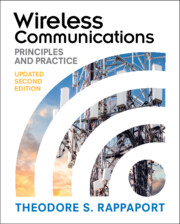Refine search
Actions for selected content:
6829 results in Communications and signal processing
6 - Norms and Procrustes Problems
-
- Book:
- Linear Algebra for Data Science, Machine Learning, and Signal Processing
- Published online:
- 01 November 2024
- Print publication:
- 16 May 2024, pp 197-237
-
- Chapter
- Export citation

Wireless Communications
- Principles and Practice
-
- Published online:
- 22 March 2024
- Print publication:
- 08 February 2024
-
- Textbook
- Export citation
17 - Other Types of Coding
-
- Book:
- Essays on Coding Theory
- Published online:
- 08 March 2024
- Print publication:
- 14 March 2024, pp 424-442
-
- Chapter
- Export citation
3 - Low-Density Parity-Check Codes
-
- Book:
- Essays on Coding Theory
- Published online:
- 08 March 2024
- Print publication:
- 14 March 2024, pp 66-96
-
- Chapter
- Export citation
14 - Sequence Sets with Low Correlation
-
- Book:
- Essays on Coding Theory
- Published online:
- 08 March 2024
- Print publication:
- 14 March 2024, pp 361-379
-
- Chapter
- Export citation
Frontmatter
-
- Book:
- Essays on Coding Theory
- Published online:
- 08 March 2024
- Print publication:
- 14 March 2024, pp i-iv
-
- Chapter
- Export citation
7 - Locally Repairable Codes
-
- Book:
- Essays on Coding Theory
- Published online:
- 08 March 2024
- Print publication:
- 14 March 2024, pp 182-205
-
- Chapter
- Export citation
12 - Rank-Metric and Subspace Codes
-
- Book:
- Essays on Coding Theory
- Published online:
- 08 March 2024
- Print publication:
- 14 March 2024, pp 298-326
-
- Chapter
- Export citation
Contents
-
- Book:
- Essays on Coding Theory
- Published online:
- 08 March 2024
- Print publication:
- 14 March 2024, pp vii-x
-
- Chapter
- Export citation
4 - Polar Codes
-
- Book:
- Essays on Coding Theory
- Published online:
- 08 March 2024
- Print publication:
- 14 March 2024, pp 97-127
-
- Chapter
- Export citation
8 - Locally Decodable Codes
-
- Book:
- Essays on Coding Theory
- Published online:
- 08 March 2024
- Print publication:
- 14 March 2024, pp 206-229
-
- Chapter
- Export citation
Preface
-
- Book:
- Essays on Coding Theory
- Published online:
- 08 March 2024
- Print publication:
- 14 March 2024, pp xi-xiv
-
- Chapter
- Export citation
5 - Network Codes
-
- Book:
- Essays on Coding Theory
- Published online:
- 08 March 2024
- Print publication:
- 14 March 2024, pp 128-156
-
- Chapter
- Export citation
11 - Expander Codes
-
- Book:
- Essays on Coding Theory
- Published online:
- 08 March 2024
- Print publication:
- 14 March 2024, pp 275-297
-
- Chapter
- Export citation
2 - Coding for Erasures and Fountain Codes
-
- Book:
- Essays on Coding Theory
- Published online:
- 08 March 2024
- Print publication:
- 14 March 2024, pp 26-65
-
- Chapter
- Export citation
15 - Postquantum Cryptography
-
- Book:
- Essays on Coding Theory
- Published online:
- 08 March 2024
- Print publication:
- 14 March 2024, pp 380-403
-
- Chapter
- Export citation
13 - List Decoding
-
- Book:
- Essays on Coding Theory
- Published online:
- 08 March 2024
- Print publication:
- 14 March 2024, pp 327-360
-
- Chapter
- Export citation
6 - Coding for Distributed Storage
-
- Book:
- Essays on Coding Theory
- Published online:
- 08 March 2024
- Print publication:
- 14 March 2024, pp 157-181
-
- Chapter
- Export citation
Appendix A - Finite Geometries, Linearized Polynomials and Gaussian Coefficients
-
- Book:
- Essays on Coding Theory
- Published online:
- 08 March 2024
- Print publication:
- 14 March 2024, pp 443-449
-
- Chapter
- Export citation
10 - Batch Codes
-
- Book:
- Essays on Coding Theory
- Published online:
- 08 March 2024
- Print publication:
- 14 March 2024, pp 255-274
-
- Chapter
- Export citation
